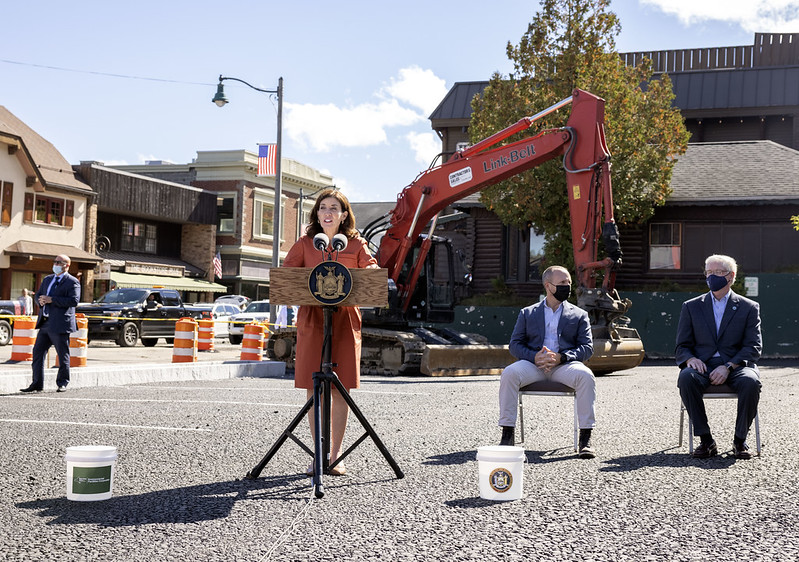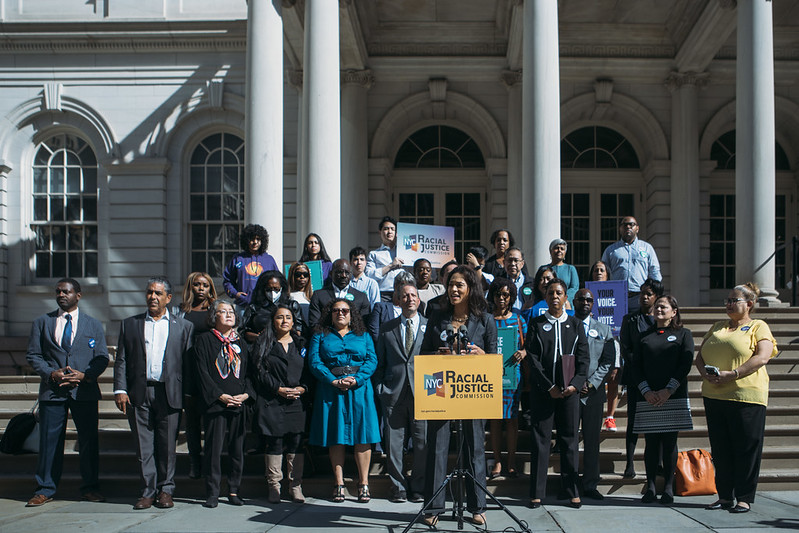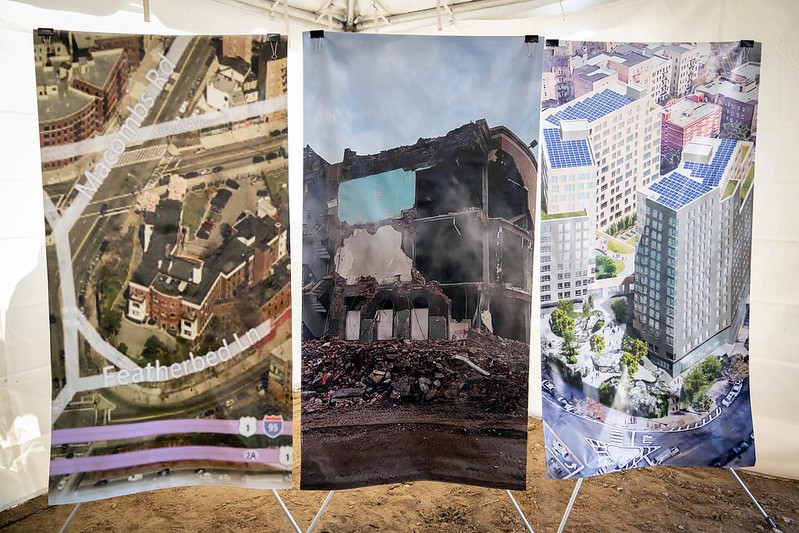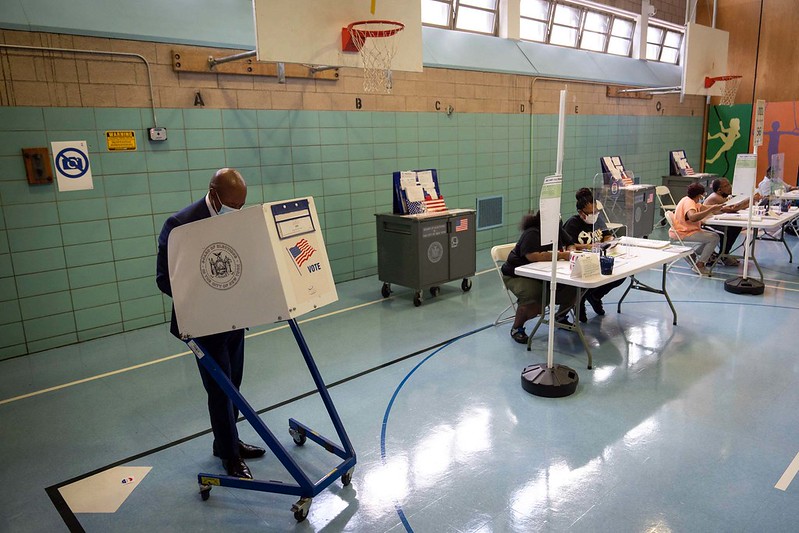Health and Transportation Benefits from Congestion Pricing Could Be Truly Transformative
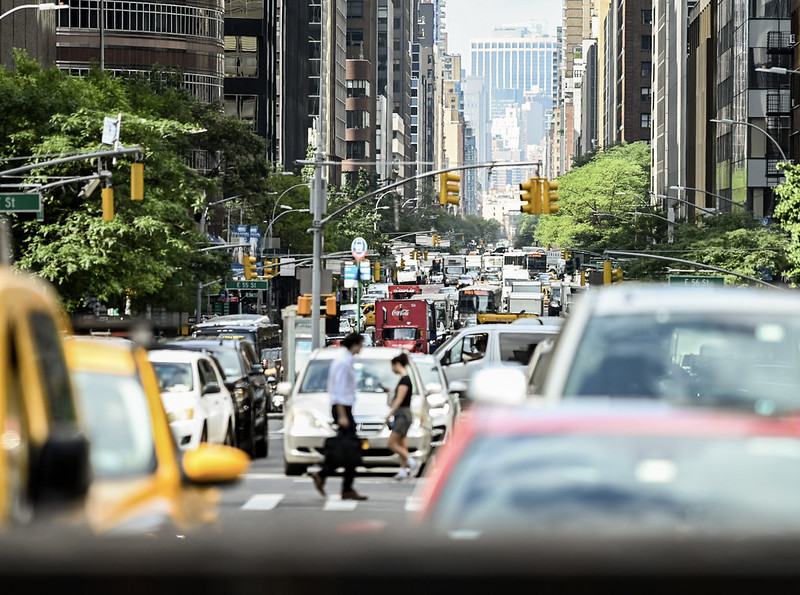
Manhattan traffic (photo: Marc A. Hermann/MTA)
Traffic pollutes, and air pollution results in poorer health. This means higher rates of asthma, lower birth weights, and a greater risk of maternal health problems.
As health and transportation policy experts, we see that congestion pricing in New York City will be a win for our region – not only for transportation flow, but also for air quality and public health.
Vehicle emissions are a major source of nitrogen oxides (NOx), volatile organic compounds (VOCs), and particulate matter in urban areas. In addition to polluting the air, these emissions also increase surface pollution, especially in the summertime. Reducing traffic will immediately improve air quality. That, it turns out, can also result in rapid improvements in health – a fundamental reason why we are eager to see the congestion pricing plan move forward.
Formally known as the Central Business District Tolling Program, congestion pricing places a fee on vehicles entering Manhattan south of 61st Street in order to reduce traffic and raise revenue for public transportation. The Metropolitan Transportation Authority (MTA) is holding public hearings on the proposal now.
Environmental studies predict clear traffic reduction benefits – estimates suggest that driving will decline by almost 10% in Manhattan south of 61st Street, and the number of vehicles entering Manhattan will drop 15-20%. Air quality will also be improved – Regional Plan Association estimates show a decline of 7.5% for particulate matter in the congestion zone and the MTA’s studies show about a 1.2% drop regionwide.
Only a few other major cities around the world have mounted congestion pricing policies, including London and Stockholm. These cities have reduced congestion, controlled emissions, and created funds for public transport systems.
Studies found substantial reductions in pollution levels after the policies were implemented. For example, shortly after the implementation of a congestion pricing policy across much of Stockholm, nitrogen dioxide (NO2) concentrations and particles with an aerodynamic diameter ≤ 10 μm (PM10) dropped by 15-20% and 10-20%, respectively. Such declines did not occur in parts of the country that had no congestion pricing policy.
The New York City congestion pricing policy may result in even greater air quality and health improvements than seen in Europe, in part because the city is more densely populated and has greater health inequality. But the extent of improvement depends greatly on how the policy is implemented, and those details are being worked out now.
For example, environmental documents suggest that traffic could rise on specific highway segments in the Bronx and Staten Island. The Governor, MTA, and city leaders should take this seriously and advance a series of proposals to reduce – or even eliminate — localized traffic concerns. These include transitioning the Hunts Point food hub to electric vehicles and facilities, focusing electric vehicle infrastructure dollars to the South Bronx, boosting bus service, and directing electric bus facilities. The State Department of Transportation has billions in federal infrastructure resources from the Infrastructure Investment and Jobs Act that could be used for these investments. Many of them should be made regardless of congestion pricing – for too long certain communities have been overburdened by polluting infrastructure.
Another issue to address is so-called “toll shopping.” This describes drivers who go out of their way for the cheapest route, or “shopping” for the cheapest toll sum. A smart toll credit policy that encourages drivers to use the most direct routes will have substantial local benefits – for example, our studies have found that 25% of morning rush hour traffic on the BQE bypasses the tolled Hugh Carey tunnel to use a free East River crossing.
Congestion pricing is a win for transportation, air quality, and health. If designed well, the policy could not only surpass air pollution reductions and health impacts of any other city to date, but it could also achieve important and tangible health equity impacts in underserved communities. All while raising significant sums to fund public transit improvements for the long-term.
Let’s do this right.
***
Kate Slevin is Executive Vice President at the Regional Plan Association. Lorna Thorpe, PhD, MPH is a Professor of Epidemiology and Director of the Division of Epidemiology at NYU Langone. Rachel Weinberger, PhD is the Peter Herman Chair for Transportation at Regional Plan Association. On Twitter @RegionalPlan & @nyulangone.
***
Have an op-ed idea or submission for Gotham Gazette? Email This email address is being protected from spambots. You need JavaScript enabled to view it.
Latinos and the August 2022 New York State Senate Primary

(l-r) Nathalia Fernandez, Gustavo Rivera, Kristen Gonzalez
Last week’s primary elections for New York State Senate and U.S. House of Representatives seats included a number of competitive races, some of them in Latino-majority districts. As in any election, the implications of this primary are varied and significant.
Here are several key takeaways from State Senate races in the five boroughs.
Latino Turnout, Where Art Thou?
Voter turnout at this primary was abysmal, as was widely predicted, but especially in Latino districts—as it had been in the June primaries for statewide and Assembly seats.
According to my estimates based on voter enrollment analysis, of the 802,433 Latino registered Democratic voters in New York City, only 67,871 voted in the June primary. Yes, a paltry 8% of all eligible Latino Democratic voters went to the polls in those primaries, including the race for the party’s Democratic nomination for Governor of New York. Granted, turnout was down across all racial and ethnic backgrounds from the 2018 jump. Yet, the most significant drop in voting participation is among Latinos, followed by Asian American and African American voters, respectively, when comparing the 2018 and 2022 Democratic primaries for Governor.
As yet we have only unofficial results from this month’s primary, with thousands of absentee ballots still being tallied. But these show that Latino turnout in the August primaries has decreased even more.
Take the 78th Assembly district in the Bronx as an example, where more than half of registered voters are Latinos. The district saw a highly-competitive Assembly Democratic primary in June, along with the statewide Democratic primaries for Governor and Lieutenant Governor
This month, that Assembly district largely overlapped with two competitive primaries at the State Senate level in the 31st and 33rd Senate districts. Combined, the two Senate districts include 49 of the 52 Election Districts that make up the 78th Assembly district. Both these Senate districts had competitive primaries.
The 78th Assembly district saw a turnout of 4,163 voters in the June primary, where longtime incumbent Assemblymember Jose Rivera was defeated by George Alvarez, and Governor Kathy Hochul and Lieutenant Governor Antonio Delgado each beat two Democratic opponents. Those 4,163 voters made for an almost 47% decline from the June 2021 New York City primary cycle, which featured the highly-competitive Democratic primaries for Mayor, Comptroller, and Bronx Borough President, as well as partially overlapping races in the 14th and 15th City Council Districts.
By my calculations, only 2,963 people turned out to vote this month in the 78th Assembly district in the Bronx (that number could increase very slightly with a small number of additional absentee ballots to be counted there).
Why are the numbers so abysmal? This year’s redistricting fiasco, including a judge’s decision to force an August primary, making for two primaries in the same cycle, contributes mightily to this decline. But there are other factors too, like an uninspiring gubernatorial primary, lack of Latino political leadership, rampant poverty, voter apathy, and more.
To understand these social and political realities among Latinos, I am launching a new think tank—The Institute for Latino Politics and Policy—during Hispanic Heritage Month, which is September 15-October 15. Stay tuned for more information.
The voting apathy in the 78th Assembly district is also found in other districts with large Latino voting populations. For the sake of all Latino communities, it is high time that Latino political and community leaders, community organizations, and others set aside their personal gripes and tribalism. Of course Latinos are not a monolithic community; we come from different countries, with nuances in our language, culture, politics, and ideologies. But surely there is more that connects us than divides us.
The Senate Races
A number of this year’s competitive New York State Senate races occurred in Latino-majority or Latino-plurality districts.
In the 31st Senate district, spanning parts of Upper Manhattan and the South Bronx, three insurgents took on the incumbent senator, Robert Jackson. But Jackson’s toughest challenger was Angel Vasquez, who had the strong backing of Congressman Adriano Espaillat.
With the changes that resulted from the wacky redistricting process, the 31st Senate district experienced some radical shifts, and became much more Latino in the process. In fact, the Senate district was constructed in a way that resembles Rep. Espaillat’s own Congressional district. The new demographic reality of the district was one that on paper would give someone like Vasquez a fighting chance to defeat the incumbent.
Alas, not only did Jackson win, he won handily. In fact, Jackson’s performance was one of the most impressive of the night. He won all Assembly districts in the Senate district, except for one—the 86th Assembly district in the Bronx. And this is where it gets interesting.
Jackson defeated Vasquez in the 72nd Assembly district, which comprises 44% of the entire Senate district. In this district, 70% of all Democratic voters are Latino (overwhelmingly Dominican). And it is Espaillat’s home base.
According to the unofficial results, Jackson won 50% of the vote in the 72nd Assembly district, to Vasquez’s 42%. Jackson’s impressive victory testifies to the vast support he receives from voters of all ethnic backgrounds. He is likable, known to be thoughtful, and was a progressive before it became the political buzzword of the day.
The results of the race have major implications for Espaillat, who was not on the ballot for State Senate but for Congress. Much was said, including by me, about Espaillat’s ability to get his preferred candidates elected: Oswald Feliz and George Alvarez in the Bronx, Carmen De La Rosa and Manny De Los Santos in Manhattan, to name a few. Yet, in this case, Espaillat could not carry one of his own on his home turf. This fact alone makes Espaillat one of the night’s biggest losers. Interestingly enough, this comes on the heels of City and State listing him #1 on its “Manhattan Power 100” list. Of course, every great warrior lives to see another day. But this warrior has taken a major blow from another, Robert Jackson.
Another of Espaillat’s endorsed candidates, Miguelina Camilo, lost her race to unseat State Senator Gustavo Rivera in the Bronx. Rivera’s victory is another of the night’s most impressive wins.
Not only was Rivera vastly outspent (outside groups alone spent over $1 million to defeat him), but other major forces were out to get him: the Bronx Democratic machine, the Dinowitz father-son elected tandem, Congressman Ritchie Torres, Bronx Borough President Vanessa Gibson, and other elected officials. Prominent labor unions DC37 and 32BJ also backed Camilo.
Despite these unusual odds for an incumbent, Rivera defeated Camilo, receiving 52% of the votes in the unofficial tally. As a result of Assemblymember Jose Rivera’s defeat in the June primary, Senator Gustavo Rivera is to become the second most senior Latino elected representative in the Bronx, after Senator Jose Serrano.
Rivera’s victory may also demonstrate further that the Bronx Democratic Party is more of a paper tiger than a machine. The fact is that over the years Democratic county organizations have lost much of the power they once had. They still have influence, but for the most part the victories of many insurgent candidates over machine-backed candidates in recent years demonstrate county organizations’ waning power. Senator Rivera’s victory continues to show that great candidates, with a strong and organized campaign operation to back them, and enough money to put it together, can defeat county organizations.
In the 34th Senate district, a district covering the Northeast Bronx and a sliver of Westchester, Assemblymember Nathalia Fernandez handily defeated two other candidates in an ‘open’ race to replace State Senator Alessandra Biaggi, who declined to run for reelection to unsuccessfully pursue a seat in Congress.
And in the 59th Senate district, which covers stretches of western Queens and Brooklyn and a chunk of Manhattan’s East Side, newcomer Kristen Gonzalez defeated Elizabeth Crowley. Gonzalez, backed by the Democratic Socialist of America - New York City (DSA), also had to contend with the vast spending of outside forces. Yet, she won with an impressive 58% of the vote in the unofficial tally.
Gonzalez now joins Rep. Alexandria Ocasio-Cortez, State Senator Julia Salazar, Assemblymembers Jessica Gonzalez-Rojas and Marcela Mitaynes, and City Council Members Alexa Aviles and Tiffany Caban in the ranks of DSA-backed Latino elected representatives. While in some quarters the NYC DSA has been critiqued for its far-left positions on public safety and other topics, and questioned about the diversity in its leadership, it does overwhelmingly support candidates of color, particularly Latinos. Would it be a stretch to say that in some Latino-plurality districts there seems to be a return to electing Latino socialists? Or does this merely reflect the cyclical nature of politics? Maybe both. As I pointed out in a recent column, and will develop in a forthcoming piece, the very first Latino elected official in our state’s history was a socialist, Puerto Rican Oscar Garcia Rivera.
Lastly, despite abysmal turnout, the election of Latinas is a welcome breath of fresh air, and adds to overall Latino representation in the State Senate.
The new Fernandez and Gonzalez victories in their primaries (with an overwhelmingly Democratic electorate, both are all but assured of winning in the fall general election), combined with the virtually certain re-election of the other Latino senators — Jessica Ramos, Gustavo Rivera, Julia Salazar, Luis Sepulveda, Jose Serrano — will increase Latino representation in the Senate to at least seven.
A potential victory by Democratic nominee Monica Martinez on Long Island in November could increase Latino representation in the State Senate to eight in the 63-seat upper chamber of the Legislature. And five of the eight would be Latinas, with three of the five of Colombian descent — Nathalia Fernandez, Jessica Ramos, Julia Salazar. Now that’s worth celebrating!
***
Eli Valentin is a political analyst and author of the forthcoming book, Reinhold Niebuhr: A Political Life. On Twitter @EliValentinNY.
My Son is Gone, But the Pain Remains; Here’s How I Got Help and Help Others

Mothers who have lost children to gun violence (photo: Michael Appleton/Mayor's Office)
When I lost my son Keondre to gun violence last year, my whole life came crashing down. At only 18, Keondre was senselessly shot multiple times. He went into the neighborhood deli, and he never came out.
Though I didn’t give birth to him, I raised him. He was with me from the time he was four years old.
My memories of Keondre replay over and over again. I remember his bright spirit. How he was always helping me with my bags, joining the community clean-up crew, tutoring his younger cousins, teaching kids how to play basketball. Keondre was a stellar student. He had no prior criminal trouble.
Keondre was a light that brought joy to others. He was raised by a village of aunts, sisters, uncles, and family friends who loved him. Yet that could not keep him safe.
And I am not alone in this. Far too many mothers and parents are losing their children to this numbing violence. Everyday there is another report of a fatal shooting of a young person. Of another bullet that has destroyed countless lives.
The pain of these losses will stay with me for the rest of my life. But, with support, I have been able to find ways to cope.
To talk through my feelings in-depth, I turned to Safe Horizon, the nation’s largest victim services agency, for grief counseling. I was introduced to a social worker, Grace, who I can call anytime. She has always been there whenever I need her. Grace’s genuine interest in me and my healing has built a relationship that makes me feel that she is here for me.
Grief counseling has helped me so much that I find myself offering what I have learned to others. In addition to counseling, Grace helped me access victim services for help with funeral expenses and also helped with navigating many difficult processes. I want others who have lost loved ones to gun violence to know this kind of support is available, free of charge.
I want people to know that it's OK to reach out for help when you are hurting. Especially for people of color, we have a stigma in our communities about counseling and therapy. Don’t let that stop you from getting the help you need.
You do not have to feel ashamed or embarrassed about asking for help. When we feel like we already take on the weight of the world, this cannot be another thing to handle on our own.
And we have to take care of ourselves so that we can keep fighting for our community. Because I get the support I need, I have the strength to keep going. As long as there is breath in my body, I will use Keondre as a vessel to save other young men in this community. And I will keep reaching out for the help I need to do that.
I will never get Keondre back, and that will never stop hurting. But, with help, I can regain some of the joy that he, and his memories, brought to my life.
***
Heather Colbourne lost her son in November 2021. She lives on Staten Island and is a community advocate for survivors in the fight to eradicate gun violence. Safe Horizon is the nation’s largest victims service agency. If you have lost a loved one to gun violence in New York City, call 1-800-621-HOPE.
***
Have an op-ed idea or submission for Gotham Gazette? Email This email address is being protected from spambots. You need JavaScript enabled to view it.

